Deployment of two-tier application with Docker Network
 Siddhartha Gaurav
Siddhartha Gaurav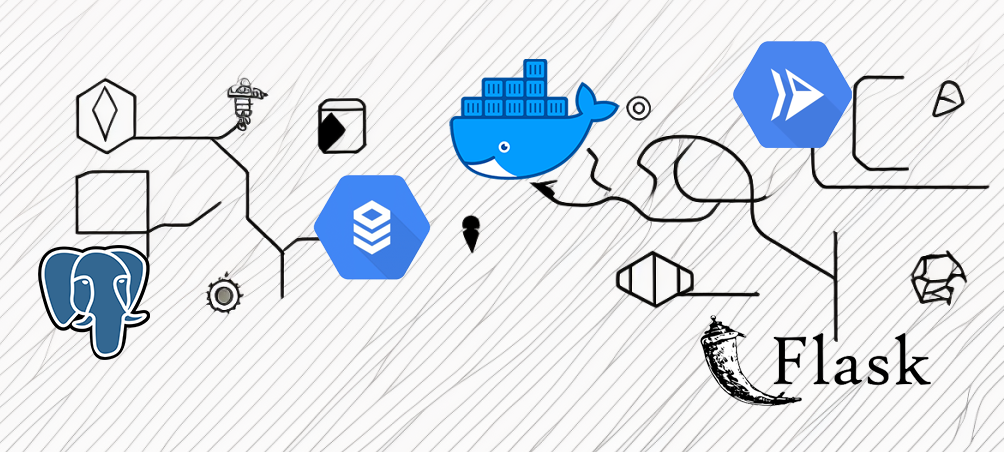
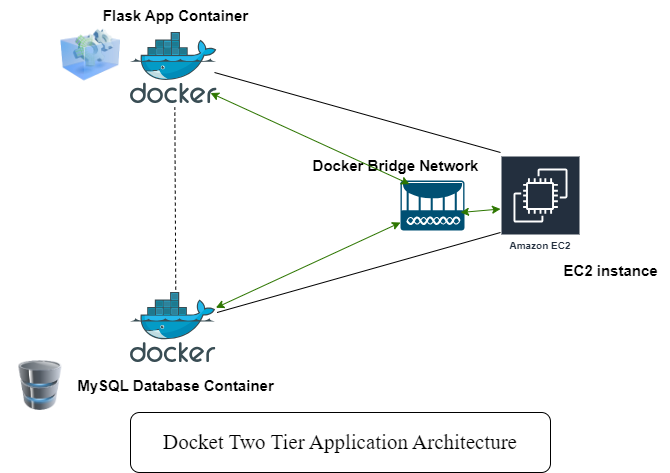
What is a two-tier application??
A two-tier application refers to a software architecture where the application is divided into two main parts or tiers: the client (or front-end) tier and the server (or back-end) tier. In the case described, the two tiers are represented by:
Application Tier (Front-end): This is where the Python Flask app resides. It's the user interface or the part of the application that users interact with. The Flask app handles user requests, processes them, and communicates with the database tier to store or retrieve data.
Database Tier (Back-end): This is the MySQL database container. It's responsible for storing and managing the data used by the Flask app. The Flask app communicates with the database tier to store information (write) or retrieve information (read).
The two-tier architecture is a common setup, especially in simpler applications. It separates the user interface and application logic from the data storage and retrieval, making it easier to manage and scale each tier independently.
Deploying a two-tier application
We're setting up a Python Flask app that talks to a MySQL database. There are two parts to this setup: one container for the app and another for the database. These two containers are isolated to each other.
Here's the key thing: the database container needs to be up and running before we start the Flask app container. Why? Because the app needs the database to save and fetch data. Without the database container, the app won't be able to handle data properly.
So, let's begin and deploy our first two-tier application -
Clone the Git repository using the following command in your terminal or command prompt:
ubuntu@ip-172-31-47-90:~/projects$ git clone https://github.com/sgaurav7/two-tier-flask-app.git Cloning into 'two-tier-flask-app'... remote: Enumerating objects: 140, done. remote: Counting objects: 100% (77/77), done. remote: Compressing objects: 100% (38/38), done. remote: Total 140 (delta 62), reused 39 (delta 39), pack-reused 63 Receiving objects: 100% (140/140), 35.15 KiB | 3.51 MiB/s, done. Resolving deltas: 100% (69/69), done. ubuntu@ip-172-31-47-90:~/projects$ ubuntu@ip-172-31-47-90:~/projects$ ls two-tier-flask-app ubuntu@ip-172-31-47-90:~/projects$Navigate to the 'two-tier-flask-app' directory using the 'cd' command in your terminal or command prompt:
ubuntu@ip-172-31-47-90:~/projects$ cd two-tier-flask-app/ ubuntu@ip-172-31-47-90:~/projects/two-tier-flask-app$ ubuntu@ip-172-31-47-90:~/projects/two-tier-flask-app$ ls Dockerfile Jenkinsfile README.md app.py docker-compose.yml eks-manifests k8s message.sql requirements.txt templates ubuntu@ip-172-31-47-90:~/projects/two-tier-flask-app$ ubuntu@ip-172-31-47-90:~/projects/two-tier-flask-app$Let's create a dockerfile for our application.
# Use an official Python runtime as the base image FROM python:3.9-slim # Set the working directory in the container WORKDIR /app # install required packages for system RUN apt-get update \ && apt-get upgrade -y \ && apt-get install -y gcc default-libmysqlclient-dev pkg-config \ && rm -rf /var/lib/apt/lists/* # Copy the requirements file into the container COPY requirements.txt . # Install app dependencies RUN pip install mysqlclient RUN pip install --no-cache-dir -r requirements.txt # Copy the rest of the application code COPY . . # Specify the command to run your application CMD ["python", "app.py"]Build an image using the Dockerfile you created. Open a terminal or command prompt in the project directory and run the following command:
ubuntu@ip-172-31-47-90:~/projects/two-tier-flask-app$ docker build -t flask-app:latest . DEPRECATED: The legacy builder is deprecated and will be removed in a future release. Install the buildx component to build images with BuildKit: https://docs.docker.com/go/buildx/ Sending build context to Docker daemon 134.1kB Step 1/8 : FROM python:3.9-slim 3.9-slim: Pulling from library/python 1f7ce2fa46ab: Pull complete 1fb7efcf9eab: Pull complete 07483b63eff3: Pull complete 3d52c1551390: Pull complete 732bf57bb511: Pull complete Digest: sha256:c54eecbf55a7527c913aef9a90e310c03bb78bea2204be57f39b28e43ab733ab Status: Downloaded newer image for python:3.9-slim ---> db813260829a Step 2/8 : WORKDIR /app ---> Running in aad8f571011c Removing intermediate container aad8f571011c ---> 004aeb1be581 Step 3/8 : RUN apt-get update && apt-get upgrade -y && apt-get install -y gcc default-libmysqlclient-dev pkg-config && rm -rf /var/lib/apt/lists/* ---> Running in 19cd424d566c Get:1 http://deb.debian.org/debian bookworm InRelease [151 kB] Get:2 http://deb.debian.org/debian bookworm-updates InRelease [52.1 kB] Get:3 http://deb.debian.org/debian-security bookworm-security InRelease [48.0 kB] Get:4 http://deb.debian.org/debian bookworm/main amd64 Packages [8780 kB] Get:5 http://deb.debian.org/debian bookworm-updates/main amd64 Packages [6668 B] Get:6 http://deb.debian.org/debian-security bookworm-security/main amd64 Packages [103 kB] Fetched 9141 kB in 2s (6087 kB/s) Reading package lists... Reading package lists... Building dependency tree... Reading state information... Calculating upgrade... 0 upgraded, 0 newly installed, 0 to remove and 0 not upgraded. Reading package lists... Building dependency tree... Reading state information... Processing triggers for libc-bin (2.36-9+deb12u3) ... Removing intermediate container 19cd424d566c ---> 171b973ab65c Step 4/8 : COPY requirements.txt . ---> 84d75450e9a2 Step 5/8 : RUN pip install mysqlclient ---> Running in 0f52e13662f0 Collecting mysqlclient Downloading mysqlclient-2.2.0.tar.gz (89 kB) ━━━━━━━━━━━━━━━━━━━━━━━━━━━━━━━━━━━━━━━━ 89.5/89.5 kB 3.5 MB/s eta 0:00:00 Installing build dependencies: started Installing build dependencies: finished with status 'done' Getting requirements to build wheel: started Getting requirements to build wheel: finished with status 'done' Installing backend dependencies: started Installing backend dependencies: finished with status 'done' Preparing metadata (pyproject.toml): started Preparing metadata (pyproject.toml): finished with status 'done' Building wheels for collected packages: mysqlclient Building wheel for mysqlclient (pyproject.toml): started Building wheel for mysqlclient (pyproject.toml): finished with status 'done' Created wheel for mysqlclient: filename=mysqlclient-2.2.0-cp39-cp39-linux_x86_64.whl size=131073 sha256=4603020e214b72043e048140ea6a519661acf238b93da73f646a902a9c66010c Stored in directory: /root/.cache/pip/wheels/aa/58/d4/2e7a1d266508fd74887c2f74ec1ae819509bae6711480d8666 Successfully built mysqlclient Installing collected packages: mysqlclient Successfully installed mysqlclient-2.2.0 WARNING: Running pip as the 'root' user can result in broken permissions and conflicting behaviour with the system package manager. It is recommended to use a virtual environment instead: https://pip.pypa.io/warnings/venv [notice] A new release of pip is available: 23.0.1 -> 23.3.1 [notice] To update, run: pip install --upgrade pip Removing intermediate container 0f52e13662f0 ---> 56ed5de0d590 Step 6/8 : RUN pip install --no-cache-dir -r requirements.txt ---> Running in fd8712125839 Collecting Flask==2.0.1 Downloading Flask-2.0.1-py3-none-any.whl (94 kB) ━━━━━━━━━━━━━━━━━━━━━━━━━━━━━━━━━━━━━━━━ 94.8/94.8 kB 4.7 MB/s eta 0:00:00 Collecting Flask-MySQLdb==0.2.0 Downloading Flask-MySQLdb-0.2.0.tar.gz (2.1 kB) Preparing metadata (setup.py): started Preparing metadata (setup.py): finished with status 'done' Collecting requests==2.26.0 Downloading requests-2.26.0-py2.py3-none-any.whl (62 kB) ━━━━━━━━━━━━━━━━━━━━━━━━━━━━━━━━━━━━━━━ 62.3/62.3 kB 118.9 MB/s eta 0:00:00 Collecting Werkzeug==2.2.2 Downloading Werkzeug-2.2.2-py3-none-any.whl (232 kB) ━━━━━━━━━━━━━━━━━━━━━━━━━━━━━━━━━━━━━━ 232.7/232.7 kB 70.2 MB/s eta 0:00:00 Collecting Jinja2>=3.0 Downloading Jinja2-3.1.2-py3-none-any.whl (133 kB) ━━━━━━━━━━━━━━━━━━━━━━━━━━━━━━━━━━━━━ 133.1/133.1 kB 136.6 MB/s eta 0:00:00 Collecting itsdangerous>=2.0 Downloading itsdangerous-2.1.2-py3-none-any.whl (15 kB) Collecting click>=7.1.2 Downloading click-8.1.7-py3-none-any.whl (97 kB) ━━━━━━━━━━━━━━━━━━━━━━━━━━━━━━━━━━━━━━━ 97.9/97.9 kB 129.6 MB/s eta 0:00:00 Requirement already satisfied: mysqlclient in /usr/local/lib/python3.9/site-packages (from Flask-MySQLdb==0.2.0->-r requirements.txt (line 2)) (2.2.0) Collecting charset-normalizer~=2.0.0 Downloading charset_normalizer-2.0.12-py3-none-any.whl (39 kB) Collecting idna<4,>=2.5 Downloading idna-3.4-py3-none-any.whl (61 kB) ━━━━━━━━━━━━━━━━━━━━━━━━━━━━━━━━━━━━━━━━ 61.5/61.5 kB 94.6 MB/s eta 0:00:00 Collecting urllib3<1.27,>=1.21.1 Downloading urllib3-1.26.18-py2.py3-none-any.whl (143 kB) ━━━━━━━━━━━━━━━━━━━━━━━━━━━━━━━━━━━━━ 143.8/143.8 kB 128.7 MB/s eta 0:00:00 Collecting certifi>=2017.4.17 Downloading certifi-2023.11.17-py3-none-any.whl (162 kB) ━━━━━━━━━━━━━━━━━━━━━━━━━━━━━━━━━━━━━ 162.5/162.5 kB 134.3 MB/s eta 0:00:00 Collecting MarkupSafe>=2.1.1 Downloading MarkupSafe-2.1.3-cp39-cp39-manylinux_2_17_x86_64.manylinux2014_x86_64.whl (25 kB) Building wheels for collected packages: Flask-MySQLdb Building wheel for Flask-MySQLdb (setup.py): started Building wheel for Flask-MySQLdb (setup.py): finished with status 'done' Created wheel for Flask-MySQLdb: filename=Flask_MySQLdb-0.2.0-py3-none-any.whl size=2663 sha256=bda01f80005136964046f68d44587597a2f48c5a217545c69a34b3e8380f3fb3 Stored in directory: /tmp/pip-ephem-wheel-cache-0r3alu5a/wheels/41/ab/e5/ac1bfe8e719b0c95880c23643ce001363e8240f615f260755e Successfully built Flask-MySQLdb Installing collected packages: urllib3, MarkupSafe, itsdangerous, idna, click, charset-normalizer, certifi, Werkzeug, requests, Jinja2, Flask, Flask-MySQLdb Successfully installed Flask-2.0.1 Flask-MySQLdb-0.2.0 Jinja2-3.1.2 MarkupSafe-2.1.3 Werkzeug-2.2.2 certifi-2023.11.17 charset-normalizer-2.0.12 click-8.1.7 idna-3.4 itsdangerous-2.1.2 requests-2.26.0 urllib3-1.26.18 WARNING: Running pip as the 'root' user can result in broken permissions and conflicting behaviour with the system package manager. It is recommended to use a virtual environment instead: https://pip.pypa.io/warnings/venv [notice] A new release of pip is available: 23.0.1 -> 23.3.1 [notice] To update, run: pip install --upgrade pip Removing intermediate container fd8712125839 ---> 01f67a9ffdd2 Step 7/8 : COPY . . ---> 400d333b673c Step 8/8 : CMD ["python", "app.py"] ---> Running in a61072e978ec Removing intermediate container a61072e978ec ---> 028f8e85bb31 Successfully built 028f8e85bb31 Successfully tagged flask-app:latest ubuntu@ip-172-31-47-90:~/projects/two-tier-flask-app$To list the Docker images you've built, run the following command in your terminal or command prompt:
ubuntu@ip-172-31-47-90:~/projects/two-tier-flask-app$ docker images REPOSITORY TAG IMAGE ID CREATED SIZE flask-app latest 028f8e85bb31 2 minutes ago 391MB python 3.9-slim db813260829a 5 weeks ago 126MB ubuntu@ip-172-31-47-90:~/projects/two-tier-flask-app$To deploy the MySQL container, use the following command in your terminal or command prompt. Make sure to replace the placeholder values with your specific configuration. These environment variables are crucial for setting up the MySQL container:
ubuntu@ip-172-31-47-90:~/projects/two-tier-flask-app$ docker run -d -p 3306:3306 -e MYSQL_ROOT_PASSWORD=test@123 -e MYSQL_DATABASE-testdb -e MYSQL_USER=admin -e MYSQL_PASSWORD=admin mysql:latest Unable to find image 'mysql:latest' locally latest: Pulling from library/mysql 8e0176adc18c: Pull complete 2d2c52718f65: Pull complete d88d03ce139b: Pull complete 4a7d7f11aa1e: Pull complete ce5949193e4c: Pull complete f7f024dfb329: Pull complete 5fc3c840facc: Pull complete 509068e49488: Pull complete cbc847bab598: Pull complete 942bef62a146: Pull complete Digest: sha256:1773f3c7aa9522f0014d0ad2bbdaf597ea3b1643c64c8ccc2123c64afd8b82b1 Status: Downloaded newer image for mysql:latest 46cff555a02d27924c253d9d3d9760c5f6da93e59ec1e9c2396f0176d7e326a4 ubuntu@ip-172-31-47-90:~/projects/two-tier-flask-app$ ubuntu@ip-172-31-47-90:~/projects/two-tier-flask-app$ docker ps CONTAINER ID IMAGE COMMAND CREATED STATUS PORTS NAMES 46cff555a02d mysql:latest "docker-entrypoint.s…" 24 seconds ago Up 23 seconds 0.0.0.0:3306->3306/tcp, :::3306->3306/tcp, 33060/tcp awesome_shaw ubuntu@ip-172-31-47-90:~/projects/two-tier-flask-app$ ubuntu@ip-172-31-47-90:~/projects/two-tier-flask-app$In the above command, we are running the MySQL container in detached mode (
-d), allowing it to run in the background. We have mapped the container's port 3306 to the host's port 3306 (-p 3306:3306), enabling communication between the MySQL container and the host system.Crucially, we've provided essential environment variables:
MYSQL_ROOT_PASSWORD: This sets the root password for the MySQL server.MYSQL_DATABASE: This specifies the name of the initial database to be created when the container starts.MYSQL_USER: This defines a new MySQL user with specific privileges.MYSQL_PASSWORD: This sets the password for the MySQL user created above.
These environment variables are instrumental in configuring the MySQL container according to your specific requirements.
Once the command is executed successfully, the container is up and running, ready to handle database operations.
Now that our MySQL container is up and running, let's deploy our Flask application container in a similar manner. We'll use the 'flask-app' image that we created earlier from the Dockerfile.
Execute the following command in your terminal or command prompt:
ubuntu@ip-172-31-47-90:~/projects/two-tier-flask-app$ docker run -d -p 5000:5000 -e MYSQL_HOST=mysql -e MYSQL_USER=admin -e MYSQL_PASSWORD=admin -e MYSQL_DB=testdb --name=flask-app flask-a:latest acd1affda524f8c7ecbbf518df8c5dd9da99fdd0a1e5db4ccde41d69168bb588 ubuntu@ip-172-31-47-90:~/projects/two-tier-flask-app$ ubuntu@ip-172-31-47-90:~/projects/two-tier-flask-app$ docker ps CONTAINER ID IMAGE COMMAND CREATED STATUS PORTS NAMES acd1affda524 flask-app:latest "python app.py" 6 seconds ago Up 3 seconds 0.0.0.0:5000->5000/tcp, :::5000->5000/tcp flask-app 46cff555a02d mysql:latest "docker-entrypoint.s…" 10 minutes ago Up 10 minutes 0.0.0.0:3306->3306/tcp, :::3306->3306/tcp, 33060/tcp awesome_shaw ubuntu@ip-172-31-47-90:~/projects/two-tier-flask-app$In the above command, we are deploying a container for the 'flask-app' using the image created earlier. The application within the container will be accessible on port 5000, and we've mapped that to the host system using the flag (-p 5000:5000).
To ensure the Flask app communicates effectively with the MySQL database, we've provided the necessary environment variables:
-e DB_HOST=mysql: Specifies the hostname of the MySQL database container.-e DB_PORT=3306: Sets the port on which the MySQL database is running.-e DB_USER=admin: Defines the MySQL user that the Flask app will use.-e DB_PASSWORD=admin: Sets the password for the MySQL user.-e DB_NAME=testdb: Specifies the name of the MySQL database.
These environment variables are essential for establishing a seamless connection between the Flask application and the MySQL database.
After running this command, the Flask application container will be up and running, ready to serve requests on port 5000, interacting with the MySQL container using the provided configuration.
Now, let's access the application from your host by opening a web browser and navigating to the IP address of your EC2 instance followed by port 5000 (e.g.,
http://your_ec2_ip:5000).In the case of an EC2 instance, ensure that you have allowed traffic on port 5000 in your Security Group settings. This step is crucial for external access to the Flask application. If you haven't done so already, add an inbound rule to allow traffic on port 5000.
Once the Security Group is configured, you should be able to see and interact with your Flask application through the specified IP address and port.

After allowing the necessary ports in your Security Group, open your web browser and enter the following address: http://your-ip:5000
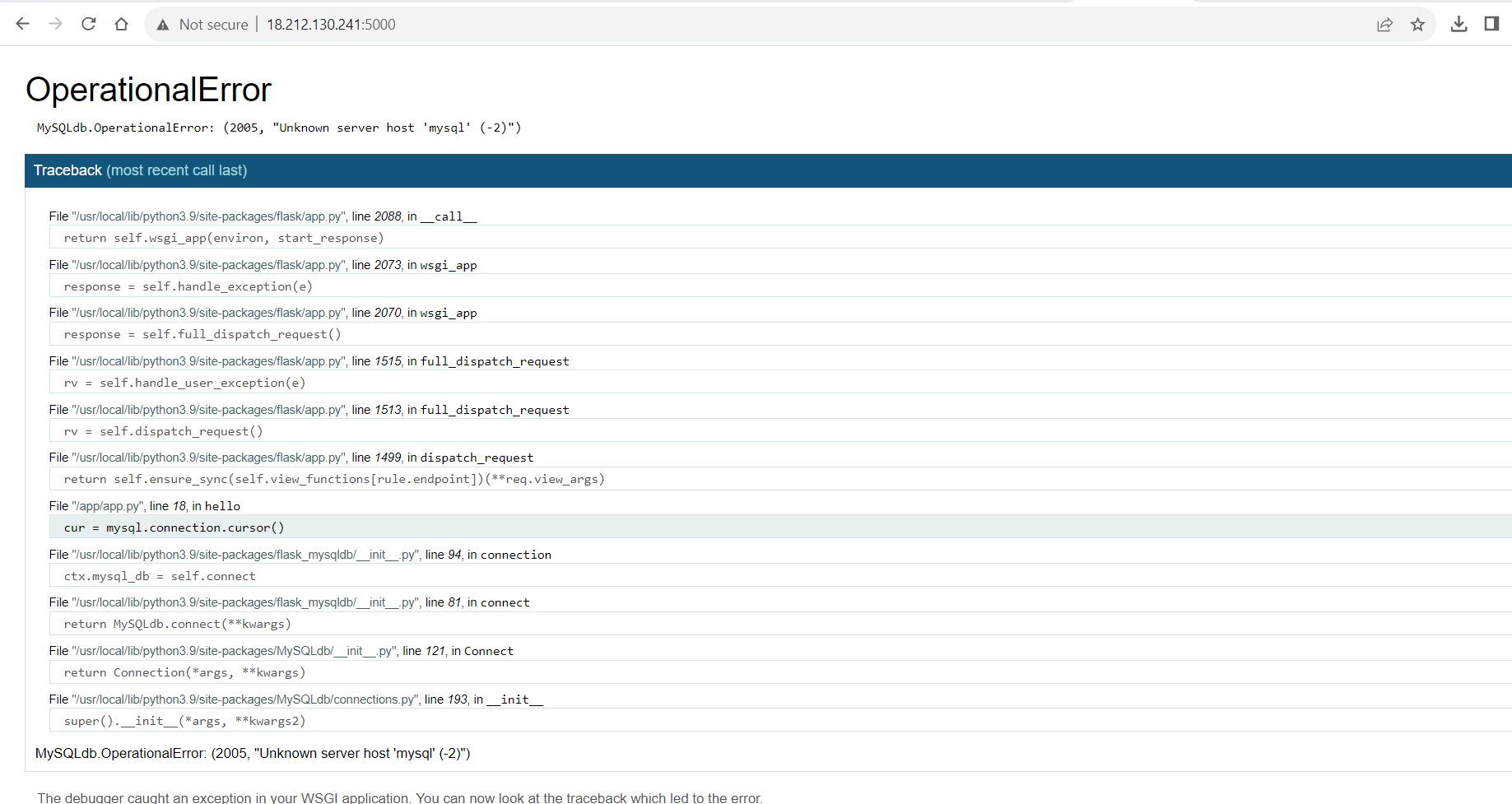
The error you're encountering indicates a communication issue between the Flask application and the MySQL database. This is likely due to both containers running on separate networks.
To resolve this, consider creating a Docker network and connecting both containers to it. This enables them to communicate seamlessly. Here are the steps:
ubuntu@ip-172-31-47-90:~$ docker network ls NETWORK ID NAME DRIVER SCOPE 9fdeca56567d bridge bridge local 9cab723192ad host host local 87f298874199 none null local ubuntu@ip-172-31-47-90:~$ ubuntu@ip-172-31-47-90:~$ docker network create -d bridge two-tier-app-nw 0199a9102bea5130ce4f3aa70738014f45d1005951429ace7609da6dfd4b60d2 ubuntu@ip-172-31-47-90:~$ ubuntu@ip-172-31-47-90:~$ docker network ls NETWORK ID NAME DRIVER SCOPE 9fdeca56567d bridge bridge local 9cab723192ad host host local 87f298874199 none null local 0199a9102bea two-tier-app-nw bridge local ubuntu@ip-172-31-47-90:~$In the previous step, we established a bridge network named 'two-tier-app-nw' using the following Docker command:
docker network create -d bridge two-tier-app-nwHere, the
-dflag allows us to specify the network driver, and 'bridge' is chosen as the driver type. Bridge networks are often preferred for enabling communication between containers on the same host.This network will serve as the shared space for our MySQL and Flask application containers, facilitating seamless communication between them
Let's inspect the 'two-tier-app-nw' network to gather information about its configuration, including the connected containers. Execute the following command in your terminal or command prompt:
ubuntu@ip-172-31-47-90:~$ docker network inspect two-tier-app-nw [ { "Name": "two-tier-app-nw", "Id": "0199a9102bea5130ce4f3aa70738014f45d1005951429ace7609da6dfd4b60d2", "Created": "2023-11-26T13:11:29.076831355Z", "Scope": "local", "Driver": "bridge", "EnableIPv6": false, "IPAM": { "Driver": "default", "Options": {}, "Config": [ { "Subnet": "172.18.0.0/16", "Gateway": "172.18.0.1" } ] }, "Internal": false, "Attachable": false, "Ingress": false, "ConfigFrom": { "Network": "" }, "ConfigOnly": false, "Containers": {}, "Options": {}, "Labels": {} } ] ubuntu@ip-172-31-47-90:~$The inspection result indicates that currently, no containers are bound to the 'two-tier-app-nw' network. To ensure proper communication between our MySQL and Flask application containers, both containers need to be connected to this network.
Let's create the necessary containers within our newly created bridge network named 'two-tier-app-nw.' Execute the following commands to launch the containers in this specific network:
ubuntu@ip-172-31-47-90:~$ docker run -d -p 3306:3306 -e MYSQL_ROOT_PASSWORD=test@123 -e MYSQL_DATABASE=testdb -e MYSQL_USER=admin -e MYSQL_PASSWORD=admin --network two-tier-app-nw --name mysql mysql:latest 8a6c4b1e8b09312c87e05320c6ab6c57dc7e6d395a3f2c8dff31f1971d3a348d ubuntu@ip-172-31-47-90:~$ ubuntu@ip-172-31-47-90:~$ docker run -d -p 5000:5000 -e MYSQL_HOST=mysql -e MYSQL_USER=admin -e MYSQL_PASSWORD=admin -e MYSQL_DB=testdb --network two-tier-app-nw --name=flask-app flask-app:latest d61530c6fde9459338f87d1ac2880aa824ee113248c95396f2c6aef13ac4a0a3 ubuntu@ip-172-31-47-90:~$ ubuntu@ip-172-31-47-90:~$ docker ps CONTAINER ID IMAGE COMMAND CREATED STATUS PORTS NAMES 8a6c4b1e8b09 mysql:latest "docker-entrypoint.s…" 40 seconds ago Up 39 seconds 0.0.0.0:3306->3306/tcp, :::3306->3306/tcp, 33060/tcp mysql d61530c6fde9 flask-app:latest "python app.py" 9 minutes ago Up 9 minutes 0.0.0.0:5000->5000/tcp, :::5000->5000/tcp flask-app ubuntu@ip-172-31-47-90:~$ ubuntu@ip-172-31-47-90:~$-In the preceding command, we utilized the
--networkoption to explicitly designate the network to which the containers should be connected and operate within. This ensures that both the MySQL and Flask application containers are part of the same network, enabling seamless communication between them.Let's inspect the 'two-tier-app-nw' bridge network again to ensure that the containers are now connected to it. Execute the following command in your terminal or command prompt:
ubuntu@ip-172-31-47-90:~$ docker network inspect two-tier-app-nw [ { "Name": "two-tier-app-nw", "Id": "0199a9102bea5130ce4f3aa70738014f45d1005951429ace7609da6dfd4b60d2", "Created": "2023-11-26T13:11:29.076831355Z", "Scope": "local", "Driver": "bridge", "EnableIPv6": false, "IPAM": { "Driver": "default", "Options": {}, "Config": [ { "Subnet": "172.18.0.0/16", "Gateway": "172.18.0.1" } ] }, "Internal": false, "Attachable": false, "Ingress": false, "ConfigFrom": { "Network": "" }, "ConfigOnly": false, "Containers": { "8a6c4b1e8b09312c87e05320c6ab6c57dc7e6d395a3f2c8dff31f1971d3a348d": { "Name": "mysql", "EndpointID": "78a6eee2fcdeeab17373618a69dcb5d4bcc53345dd7db8b023b0039072855d83", "MacAddress": "02:42:ac:12:00:02", "IPv4Address": "172.18.0.2/16", "IPv6Address": "" }, "d61530c6fde9459338f87d1ac2880aa824ee113248c95396f2c6aef13ac4a0a3": { "Name": "flask-app", "EndpointID": "aa5378f67d4ea36541ff01005bac56971f19d1f54ec99972b77252c444c6a7e9", "MacAddress": "02:42:ac:12:00:03", "IPv4Address": "172.18.0.3/16", "IPv6Address": "" } }, "Options": {}, "Labels": {} } ] ubuntu@ip-172-31-47-90:~$After inspecting the 'two-tier-app-nw' bridge network, we observe that both containers' IP configuration details are listed. This signifies that the MySQL and Flask application containers are successfully connected within the same network, establishing the necessary communication link between them.
Now that both containers are successfully connected within the same network, open your web browser and enter the given address: http://your-ip:5000
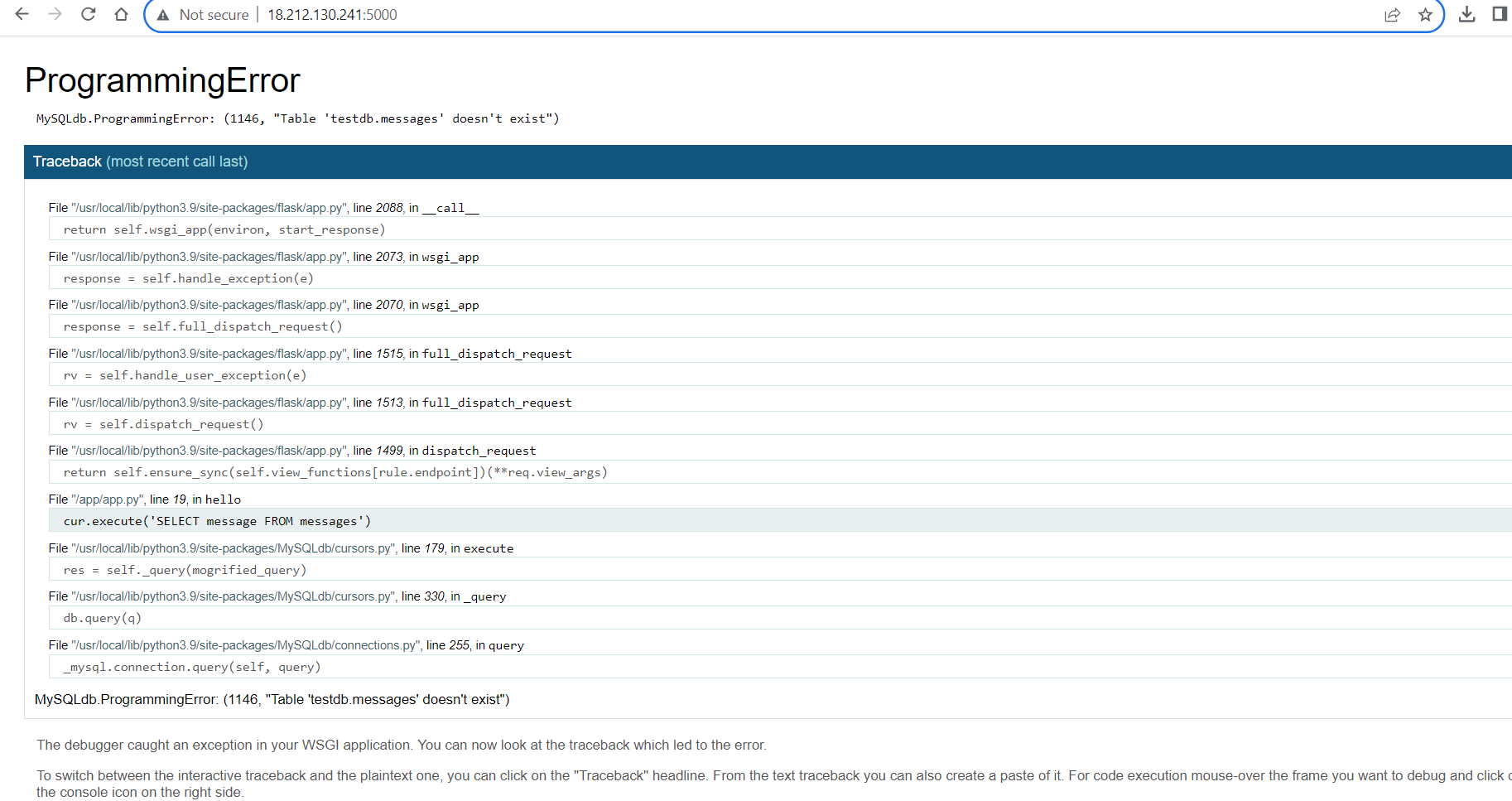
Seeing an error indicating that the required table doesn't exist? No worries. Let's log into the MySQL container and create the table. Execute the following command in your terminal or command prompt:
ubuntu@ip-172-31-47-90:~$ docker exec -it mysql bash bash-4.4# mysql -u root -p Enter password: Welcome to the MySQL monitor. Commands end with ; or \g. Your MySQL connection id is 13 Server version: 8.2.0 MySQL Community Server - GPL Copyright (c) 2000, 2023, Oracle and/or its affiliates. Oracle is a registered trademark of Oracle Corporation and/or its affiliates. Other names may be trademarks of their respective owners. Type 'help;' or '\h' for help. Type '\c' to clear the current input statement. mysql> use testdb; Database changed mysql> CREATE TABLE messages ( -> id INT AUTO_INCREMENT PRIMARY KEY, -> message TEXT -> ); Query OK, 0 rows affected (0.06 sec) mysql> exit Bye bash-4.4# exit ubuntu@ip-172-31-47-90:~$Now, let's again open the app over the web page -
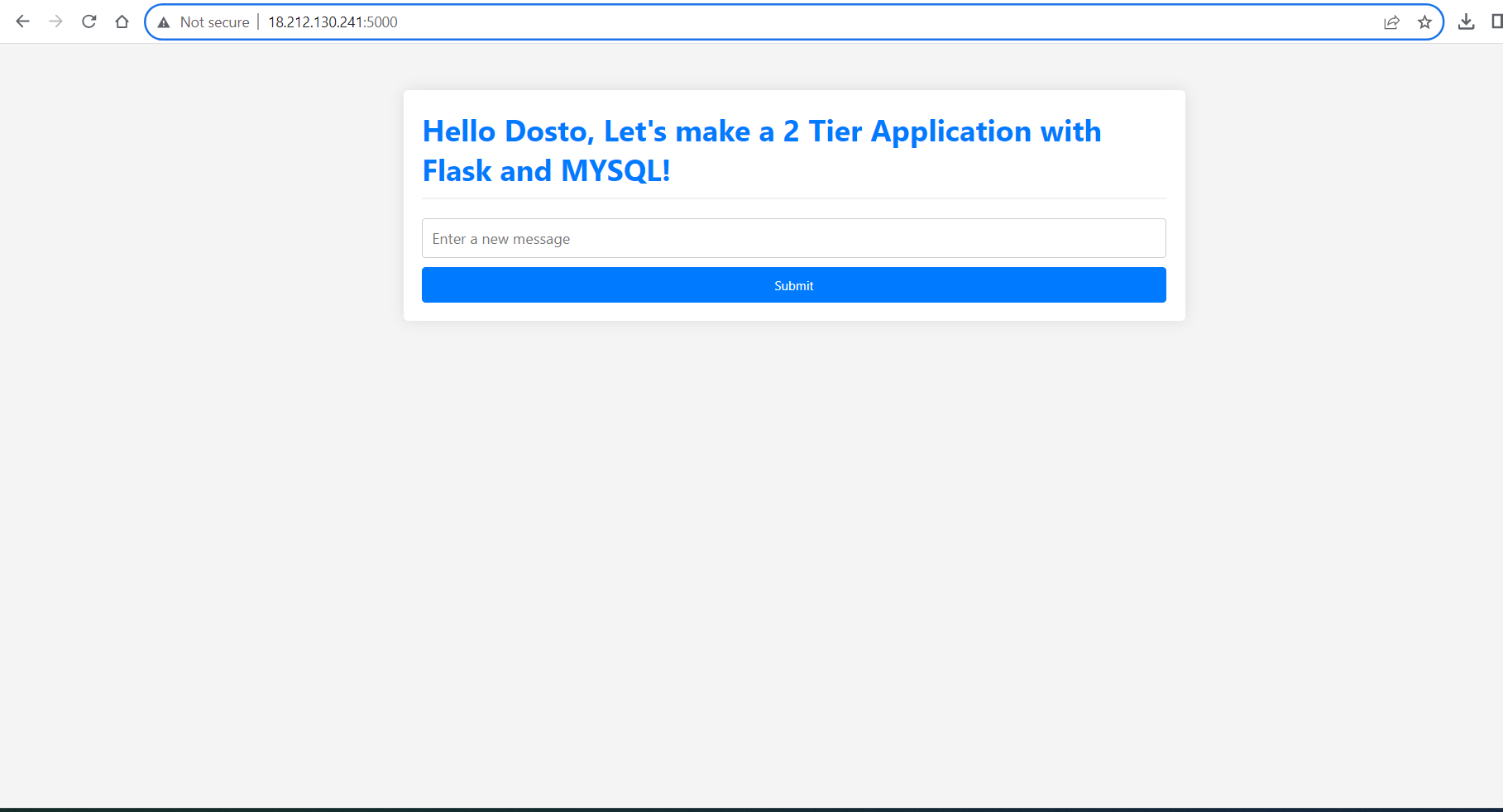
Hurray! Our two-tier application is now up and running on Docker. We've successfully deployed the frontend using Flask and the backend using MySQL as Docker containers. The seamless integration of these components demonstrates the power and flexibility of containerized applications. Congratulations on the successful setup!
Conclusion:
In conclusion, this blog has guided you through the process of setting up a robust two-tier application using Docker. From cloning the repository and creating Dockerfiles to deploying Flask and MySQL containers, we've covered each step to ensure a seamless integration of the front-end and back-end components.
By leveraging Docker's containerization, you've not only simplified the deployment process but also ensured a consistent environment for your application. The bridge network creation and container connections have facilitated efficient communication between the Flask app and MySQL database.
As you explore the possibilities of containerized applications, remember the scalability and portability benefits that Docker brings to the table. This hands-on experience lays a foundation for further customization and expansion of your projects.
Feel free to share your thoughts and experiences with containerized applications. Happy coding, and may your Dockerized applications thrive!
Subscribe to my newsletter
Read articles from Siddhartha Gaurav directly inside your inbox. Subscribe to the newsletter, and don't miss out.
Written by

Siddhartha Gaurav
Siddhartha Gaurav
I'm a passionate DevOps engineer with a knack for streamlining development workflows and ensuring seamless deployment pipelines. With experience in managing cloud infrastructure, implementing DevOps best practices, and leveraging automation tools, I thrive on tackling complex challenges and driving efficiency in software delivery. Let's connect and explore how I can contribute to your projects!